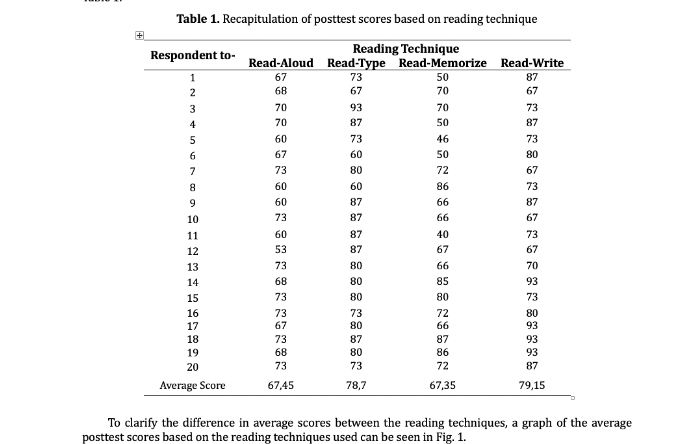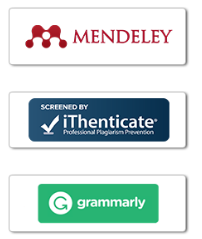Effectiveness of visual, auditory, and kinesthetic reading techniques on students’ reading comprehension: A sensory comparative study in the context of higher education
DOI:
https://doi.org/10.26555/bs.v45i1.1349Keywords:
Reading Technique, Reading Comprehension, Reading Interest, Sensory, KinestheticAbstract
Reading interest in Indonesia remains low, negatively affecting students' reading comprehension and productive skills such as writing and speaking. Although various reading techniques have been introduced, their relative effectiveness remains uncertain. This study compares the effectiveness of four reading techniques—read-aloud, read-type, read-memorize, and read-write—on students' comprehension levels. Employing a quasi-experimental design with a posttest-only control group, this research involved 80 fifth-semester students of the Indonesian Language and Literature Education Study Program at FKIP Pasundan University in the 2023/2024 academic year. The participants were randomly assigned to four treatment groups, each receiving one of the reading techniques. Comprehension was assessed using a standardized test consisting of 30 multiple-choice and short-answer questions based on Bloom’s taxonomy, supplemented by observation of student behavior during reading. Data were analyzed using ANOVA and followed by Tukey HSD post-hoc testing. The findings revealed that the read-write group achieved the highest comprehension scores, followed by read-type, while read-aloud and read-memorize showed lower and statistically insignificant differences. Techniques involving kinesthetic activities—writing and typing—were more effective, likely due to deeper cognitive engagement from motor activity. This supports the levels of processing theory, which suggests that deeper encoding occurs through active manipulation of information. These results imply that incorporating kinesthetic reading strategies into learning activities can enhance reading comprehension. Practically, educators in higher education can integrate read-write and read-type strategies into coursework to improve critical reading skills and knowledge retention.
References
Afriansyah, F., & Yanti, P. G. (2020). Keterampilan membaca puisi siswa sebuah modifikasi teknik membaca puisi Jose Rizal Manua. BAHASTRA, 40(1), 29. https://doi.org/10.26555/bahastra.v40i1.15286
Amalia, H. (2019). Efek sinar biru pada kornea, lensa, dan retina. Jurnal Biomedika dan Kesehatan, 2(1), 1–2. https://doi.org/10.18051/JBiomedKes.2019.v2.1-2
Amelia, D., Lu’lu’a, N., Diaprina, S. R., Suliyanto, Bi Arafah, N. Q., & Maromy, T. C. (2024). Variabel yang memengaruhi kemampuan literasi membaca siswa Indonesia: Analisis berdasarkan pendekatan MARS. Jurnal Pendidikan dan Kebudayaan, 9(2), 205–217.
Artrisdyanti, R. O. (2023, June 22). Membaca intensif: Pengertian, jenis, dan ciri-cirinya. Kompas. https://www.kompas.com/skola/read/2023/06/22/110000069/membaca-intensif--pengertian-jenis-dan-ciri-cirinya
Atkinson, R. C., & Shiffrin, R. M. (1968). Human memory: A proposed system and its control processes. In Psychology of Learning and Motivatio, 2, 89–195. Elsevier. https://doi.org/10.1016/S0079-7421(08)60422-3
Ayaki, M., Kawashima, M., Uchino, M., Tsubota, K., & Negishi, K. (2017). Possible association between subtypes of dry eye disease and seasonal variation. Clinical Ophthalmology, 11, 1769–1775. https://doi.org/10.2147/OPTH.S148650
Bariska, H. F., & Hariani, S. (2017). Penerapan strategi direct reading thinking activity (DRTA) untuk meningkatkan keterampilan membaca pemahaman siswa kelas V. Jurnal Pendidikan Guru Sekolah Dasar, 7(2), 1–8.
Barsalou, L. W. (2008). Grounded cognition. Annual Review of Psychology, 59(1), 617–645. https://doi.org/10.1146/annurev.psych.59.103006.093639
Boerma, I. E., Mol, S. E., & Jolles, J. (2018). Parents adjust the quality of their home literacy environment to the reading interest of their third to sixth graders. Parenting, 18(4), 243–261. https://doi.org/10.1080/15295192.2018.1524243
Boutis, K., Pecaric, M., Carrière, B., Stimec, J., Willan, A., Chan, J., & Pusic, M. (2019). The effect of testing and feedback on the forgetting curves for radiograph interpretation skills. Medical Teacher, 41(7), 756–764. https://doi.org/10.1080/0142159X.2019.1570098
Craik, F. I. M., & Lockhart, R. S. (1972). Levels of processing: A framework for memory research. Journal of Verbal Learning and Verbal Behavior, 11(6), 671–684. https://doi.org/10.1016/S0022-5371(72)80001-X
Ebbinghaus, H., Ruger, H. A., & Bussenius, C. E. (1913). Memory: A contribution to experimental psychology. Teachers College, Columbia University. https://doi.org/10.1037/10011-000
Fleming, N. D. (2011). Teaching and learning styles: VARK strategies (Revised). Neil D. Fleming.
Ghaleb, N. A., & Majeed, N. T. (2023). The role of multisensory approach in teaching writing to EFL intermediate school students. Journal of Tikrit University for Humanities, 30(7, 2), 1–25. https://doi.org/10.25130/jtuh.30.7.2.2023.22
Ginting, R. V., Ramadhani, M., & Harahap, S. A. (2024). Pengaruh teknik skimming terhadap kemampuan membaca cepat siswa pada pembelajaran bahasa Indonesia kelas IV SD Negeri 104185 Sei Semayang. Pedagogika: Jurnal Ilmu-Ilmu Kependidikan, 4(1), 92–95. https://doi.org/10.57251/ped.v4i1.1611
Indrasari, Y. (2024, April 23). UNESCO sebut minat baca orang Indonesia masih rendah. Radio Republik Indonesia (RRI). https://www.rri.co.id/daerah/649261/unesco-sebut-minat-baca-orang-indonesia-masih-rendah
Irwansyah, I., Ulinsa, U., Harisah, S., & Halifa, N. (2024). Analisis pemahaman membaca kritis mahasiswa pendidikan bahasa dan sastra Indonesia Fakultas Keguruan dan Ilmu Pendidikan Universitas Tadulako. Jurnal Onoma: Pendidikan, Bahasa, dan Sastra, 10(4), 3815–3824. https://doi.org/10.30605/onoma.v10i4.4400
James, K. H. (2017). The importance of handwriting experience on the development of the literate brain. Current Directions in Psychological Science, 26(6), 502–508. https://doi.org/10.1177/0963721417709821
James, K. H., & Engelhardt, L. (n.d.). The effects of handwriting experience on functional brain development in pre-literate children. Trends in Neuroscience and Education, 1(1), 32–42. https://doi.org/10.1016/j.tine.2012.08.001
James, K. H., & Engelhardt, L. (2012). The effects of handwriting experience on functional brain development in pre-literate children. Trends in Neuroscience and Education, 1(1), 32–42. https://doi.org/10.1016/j.tine.2012.08.001
Kalantzis, M., & Cope, B. (2020). Adding sense: Context and interest in a grammar of multimodal meaning (1st ed.). Cambridge University Press. https://doi.org/10.1017/9781108862059
Karim, A. A., & Hartati, D. (2022). Peristiwa literasi dalam novel “Di Tanah Lada” karya Ziggy Zezsyazeoviennazabrizkie dan “Merakit Kapal” karya Shion Miura. Diglosia: Jurnal Kajian Bahasa, Sastra, dan Pengajarannya, 5(4), 949—966. https://doi.org/10.30872/diglosia.v5i4.515
Kontra, C., Lyons, D. J., Fischer, S. M., & Beilock, S. L. (2015). Physical experience enhances science learning. Psychological Science, 26(6), 737–749. https://doi.org/10.1177/0956797615569355
Kucan, L., & Beck, I. L. (1997). Thinking aloud and reading comprehension research: Inquiry, instruction, and social interaction. Review of Educational Research, 67(3), 271. https://doi.org/10.2307/1170566
Makarim, F. R. (2023, July 21). Waspada radiasi blue light pada mata akibat gadget. Halodoc. https://www.halodoc.com/artikel/waspada-radiasi-blue-light-pada-mata-akibat-gadget?srsltid=AfmBOor0MFETcX4omqBiQHrJyJVpj6MXQZjjAvEn4HFjPDl36PLcZQtr
Mangen, A., & Velay, J.-L. (2010). Digitizing literacy: Reflections on the haptics of writing. In M. Hosseini (Ed.), Advances in Haptics. InTech. https://doi.org/10.5772/8710
Marwani, M., Munirah, M., & Sulfasyah, S. (2022). Pengaruh strategi pembelajaran DRTA (Directed Reading-Thinking Activity) berbantuan audio visual terhadap motivasi belajar dan kemampuan membaca pemahaman siswa kelas V. Jurnal Basicedu, 6(6), 9457–9473. https://doi.org/10.31004/basicedu.v6i6.4105
Masada, M., & Evitarini, A. (2022). Meningkatkan kemampuan membaca cepat siswa dengan teknik skimming dan scanning melalui layanan bimbingan dan konseling. Jurnal Review Pendidikan Dan Pengajaran, 5(1), 114–119. https://doi.org/10.31004/jrpp.v5i1.5347
Mayer, R. E. (2020). Multimedia learning (3rd ed.). Cambridge University Press. https://doi.org/10.1017/9781108894333.003
Moreno, R., & Mayer, R. (2007). Interactive multimodal learning environments: Special issue on interactive learning environments: Contemporary issues and trends. Educational Psychology Review, 19(3), 309–326. https://doi.org/10.1007/s10648-007-9047-2
Mueller, P. A., & Oppenheimer, D. M. (2014). The pen is mightier than the keyboard: Advantages of longhand over laptop note taking. Psychological Science, 25(6), 1159–1168. https://doi.org/10.1177/0956797614524581
Nation, K. (2019). Children’s reading difficulties, language, and reflections on the simple view of reading. Australian Journal of Learning Difficulties, 24(1), 47–73. https://doi.org/10.1080/19404158.2019.1609272
National Reading Panel. (2000). Teaching children to read: An evidence-based assessment of the scientific research literature on reading and its implications for reading instruction. Eric. https://eric.ed.gov/?id=ED444126Rahay
Paivio, A. (1986). Mental representations: A dual coding approach. Oxford University Press.
Parra G., L. (2021, January 19). The effects of multisensory approach in the development of the reading comprehension skill. Proceedings of INTCESS 2021- 8th International Conference on Education and Education of Social Sciences. INTCESS 2021- 8th International Conference on Education and Education of Social Sciences. https://doi.org/10.51508/intcess.202145
Piaget, J. (1952). The origins of intelligence in children. W. W. Norton. https://doi.org/10.1037/11494-000
Piaget, J., & Vygotsky, L. S. (1978). Mind in society: The development of higher psychological processes. Harvard University Press.
Prayogi, A., Mulyati, Y., Sastromiharjo, A., & Damaianti, V. S. (2023). Peran pengajaran membaca dan menulis dalam meningkatkan kemampuan menulis esai argumentasi. Diglosia: Jurnal Kajian Bahasa, Sastra, dan Pengajarannya, 6(1), 141–154. https://doi.org/10.30872/diglosia.v6i1.567
Pressley, M., & Afflerbach, P. (1995). Verbal protocols of reading: The nature of constructively responsive reading. Lawrence Erlbaum Associates. https://doi.org/10.2307/358808
Pujiastuti, I., Damaianti, V. S., & Syihabuddin, S. (2022). Membangun pemahaman bacaan mahasiswa melalui aktivitas pascabaca. Diglosia: Jurnal Kajian Bahasa, Sastra, dan Pengajarannya, 5(1), 119–134. https://doi.org/10.30872/diglosia.v5i1.356
Putri, A. (2023). Faktor-faktor penyebab rendahnya minat membaca siswa kelas IV di SD Negeri 1 Padas. Jurnal Pendidikan Dasar, 10(1), 87–102. https://doi.org/10.24036/sikola.v4i1.196
Rahayu, D. (2021). Kondisi minat baca di Indonesia. Jurnal Media Pustakawan, 28(2), 113–125.
Roediger, H. L., & Butler, A. C. (2011). The critical role of retrieval practice in long-term retention. Trends in Cognitive Sciences, 15(1), 20–27. https://doi.org/10.1016/j.tics.2010.09.003
Saragih, M. C. I., Sitorus, M. B. P., & Purba, J. E. (2024). Pengaruh model pembelajaran skimming terhadap hasil belajar menentukan ide pokok teks bacaan pada siswa kelas VI SD Negeri 125549 Pematangsiantar. INNOVATIVE: Journal of Social Science Research, 4(6), 420–430.
Sari, N., & Wijaya, H. (2022). Rendahnya minat membaca di kalangan mahasiswa. Jurnal Studi Sosial dan Linguistik, 5(1), 45–58.
Schunk, D. H., & Zimmerman, B. J. (2008). Motivation and self-regulated learning: Theory, research, and applications. Routledge.
Setiawan, D. (2024). Minat membaca pada mahasiswa Indonesia: Studi komparatif dengan negara ASEAN. Jurnal Psikologi dan Pendidikan, 19(2), 78–92.
Stauffer, R. G. (1969). Directing reading maturity as a cognitive process. Harper & Row.
Sweller, J. (1988). Cognitive load during problem solving: Effects on learning. Cognitive Science, 12(2), 257–285. https://doi.org/10.1207/s15516709cog1202_4
University of Idaho Writing Center Resources. (2022, February). Reading strategies: Skimming and scanning. University of Idaho Writing Center Resources. https://www.uidaho.edu/-/media/UIdaho-Responsive/Files/class/special-programs/writing-center/process/reading-strategies_skimming-and-scanning.pdf
Van Der Weel, F. R. (Ruud), & Van Der Meer, A. L. H. (2024). Handwriting but not typewriting leads to widespread brain connectivity: A high-density EEG study with implications for the classroom. Frontiers in Psychology, 14, 1219945. https://doi.org/10.3389/fpsyg.2023.1219945
Vygotsky, L. S. (1978). Mind in society: The development of higher psychological processes. Harvard University Press.
Wang, Q., Ma, M., Li, M., Huang, Y., & Wang, T. (2022). Impact of home literacy environment on literacy development of children with intellectual disabilities: A moderated mediation model. Reading & Writing Quarterly, 38(2), 126–138. https://doi.org/10.1080/10573569.2021.1923099
Wiana, W., & Nuraeni, I. (2024). Penerapan metode problem solving dalam meningkatkan kemampuan literasi membaca teks persuasi pada peserta didik kelas VIII A SMP Negeri 15 Palu. Diglosia: Jurnal Kajian Bahasa, Sastra, dan Pengajarannya, 7(3), 409–420. https://doi.org/10.30872/diglosia.v7i3.978
Windasari, W., & Gushendra, R. (2023). The effect of using skimming technique on students’ reading comprehension at SMAN 2 Karimun. Journal of English and Arabic Language Teaching, 14(2), 51–58.
Wolfe, J. L., & Neuwirth, C. M. (2001). From the margins to the center: The future of annotation. Journal of Business and Technical Communication, 15(3), 333–371. https://doi.org/10.1177/105065190101500304
Yeo, L. S., Ong, W. W., & Ng, C. M. (2014). The Home literacy environment and preschool children’s reading skills and Interest. Early Education and Development, 25(6), 791–814. https://doi.org/10.1080/10409289.2014.862147
Yusran, I. A. R. (2024, February 1). Rendahnya minat literasi di Indonesia. Kalla Institute. https://kallainstitute.ac.id/rendahnya-minat-literasi-di-indonesia/
Zahroh, N. F., & Kirani, E. D. (2024). Analisis kemampuan membaca pemahaman pada mahasiswa PBSI. EDUKATIF: Jurnal Ilmu Pendidikan, 6(2), 1051–1065. https://doi.org/10.31004/edukatif.v6i2.6135

Downloads
Published
Issue
Section
License
Copyright (c) 2025 Marlia Marlia, Tran Quoc Si

This work is licensed under a Creative Commons Attribution-ShareAlike 4.0 International License.

1.jpg)






